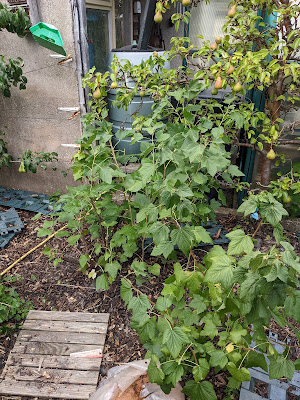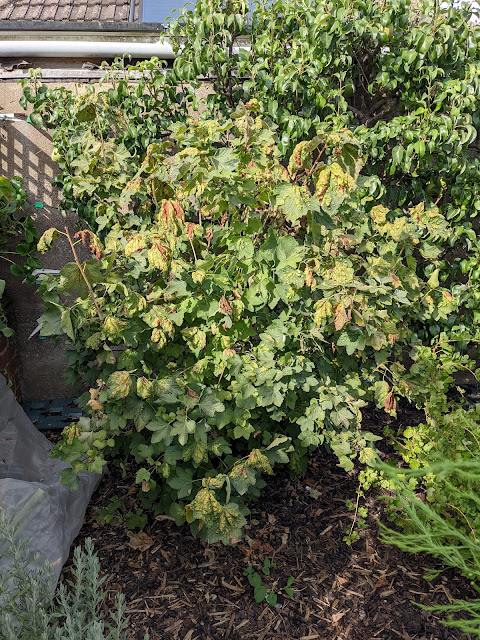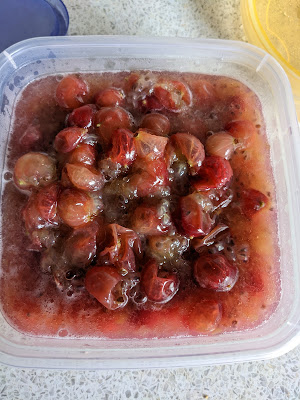We grow a variety of bush fruits in the kitchen garden - redcurrants, blackcurrants, gooseberries, and blueberries - in addition to apples, pears, grapes, rhubarb, blackberries, strawberries and raspberries. July is a busy month harvesting and preserving bush fruit.
Blackcurrants
 |
| Blackcurrants |
Blackcurrants fruit on previous year's wood - most productively on one-year old branches, less so on two-year old wood and hardly at all on three-year old branches. So, once the bush is established, expect to be removing about one third of the bush each year as you cut out the oldest branches. Unlike other currant bushes, blackcurrants can be pruned in summer while you are harvesting the berries. It can be a back-breaking job picking the currants so take this opportunity to prune out the oldest wood and then go and find a nice place to sit down and strip the fruit off the branches in comfort. To harvest the remaining berries, use a small stool so you don't strain your back. You may need to do a small amount of additional pruning in Winter to tidy the bush up (e.g. removing weak and/or low-growing stems) but that will now be a very quick job.
The two photographs below show before and after pruning/fruitpicking. The picture shows an older bush at the rear and a more recent planting in the foreground. The older bush was smothering its younger version and also reducing the amount of sunshine reaching the pear tree behind. Consequently, I have pruned the older bush a little more drastically than I normally would (and because I have 5 other blackcurrant bushes!).
 |
| Before |
 |
| After |
Maintainance and care of blackcurrants is very simple. Feed, water, pick & prune. I use wood ash from my wood burning stove to dress the bushes in winter followed by a Spring dressing of home-made compost. Summer watering after fruit set is only required during dry periods (e.g. I've watered only twice during the current drought, typically about 10 litres per bush).
Most blackcurrant varieties are cooked or made into jams/jellies but Ebony is delicious eaten raw. The 2022 blackcurrant harvest yielded 4.75 kg, enough for about 18 x 1lb jars of blackcurrant jam or 150 servings of apple and blackcurrant crumble or 3 litres of blackcurrant cordial. To freeze, for later use in any of the above recipes, simply wash, drain and spread on a tray or fill plastic boxes/bags (note the weight of fruit) and put in the freezer.
Redcurrants
 |
| Redcurrants |
We only have a single redcurrant bush after losing its partner to honey fungus in 2021. Unlike blackcurrants, redcurrants should only be hard-pruned in winter though some light pruning of new wood can be done in summer. I find it easier to just prune in winter when the leaves have dropped and you can see what you are doing. While you can train the redcurrant bush into various shapes to keep it compact, just remember that the bigger the bush the bigger the harvest. An advantage of redcurrants is that they are shade-tolerant; one of my currant bushes, albeit the one eventually infected with honey fungus, was grown next to a north-facing wall. It still managed over 10 years productive growth though.
A photograph of the redcurrant bush after fruit-picking is shown below. The leaves often look a little sad, mainly due to the presence of the currant blister aphid, but this does not seem to affect the fruit yield. I feed redcurrant bushes in exactly the same way as the blackcurrant bushes - with wood ash and home-made compost. [Note: wood ash is a good source of potash (potassium) required by all currants but its alkalinity means you shouldn't overdo its use]. Applying wood ash in winter finds an immediate outlet during its primary production period and also allows the wet weather, often associated with the English winter, to dissipate the alkalinity.
Hold the base (thicker end) of the stalk and pull through the tines of a fork to remove all the green bits...
 |
| Redcurrant Bush in front of Concorde Pear Tree |
Redcurrants are easy to pick; simply detach/pull each string of fruits from the stems/branches. The bright red colour makes it easier to spot the berries and strip the bush completely; however, you might want to leave a few currants for the birds.
This year, the redcurrant bush yielded 1.5 kg of fruit, enough to make 3x 1lb jars of redcurrant jelly. We pre-prepared the redcurrants, for jelly-making at a later date, by first stripping the berries from their strings using a fork.
 |
| Preparing redcurrants |
 |
| Before stripping |
 |
| After stripping |
Add 500 ml water to each kilogram of fruit and bring to the boil before simmering for 20 minutes while, intermittently, breaking up the fruit with a potato masher or wooden spoon...
Allow to cool slightly and sieve through a jellybag/muslin...
 |
| Jellybag and stand |
Note: if you are sieving the fruit then you can omit the destalking process though I still prefer to do it. Don't squeeze the bag to extract more juice if you want the finally redcurrant jelly to be clear/translucent though it will not affect the flavour should you decide to squeeze!
Freeze the sieved juice until required and put the fruit residue in your compost bin.
Gooseberries
My two dessert gooseberry bushes...
 |
| Whinham's Industry (WI) |
 |
| Langley Gage (LG) |
...yielded 2.3 kg in total; 1.5 kg from the more mature WI and 0.8 kg from the recently (2019) planted LG. The first pickings were eaten raw with my breakfast muesli but then it was time to harvest the whole bush (early July) and preserve the crop. I recommend thick/safety gloves to solve the thorny problem of gooseberry bushes when picking the fruit. I use these cut-resistant gloves, originally bought to wear for pruning and shredding garden waste. They resist thorns but are flexible enough for picking fruit.
To prepare the gooseberries for freezing, I top and tail using a small pair of scissors, wash in cold water...
.jpg) |
| Gooseberries - Topped, Tailed & Rinsed |
...followed by a quick rinse with boiling water (from my Quooker tap), 2 minutes in the microwave and pack into freezer boxes...
 |
| Gooseberries - microwaved & ready for freezing |
Defrost as required and use in Gooseberry Crumble or add to breakfast cereal. Personally, I find dessert gooseberries sweet enough but add honey to taste if they are still too tart. If you like lemon curd, I think you'll find gooseberry curd even nicer!






0 comments:
Post a Comment